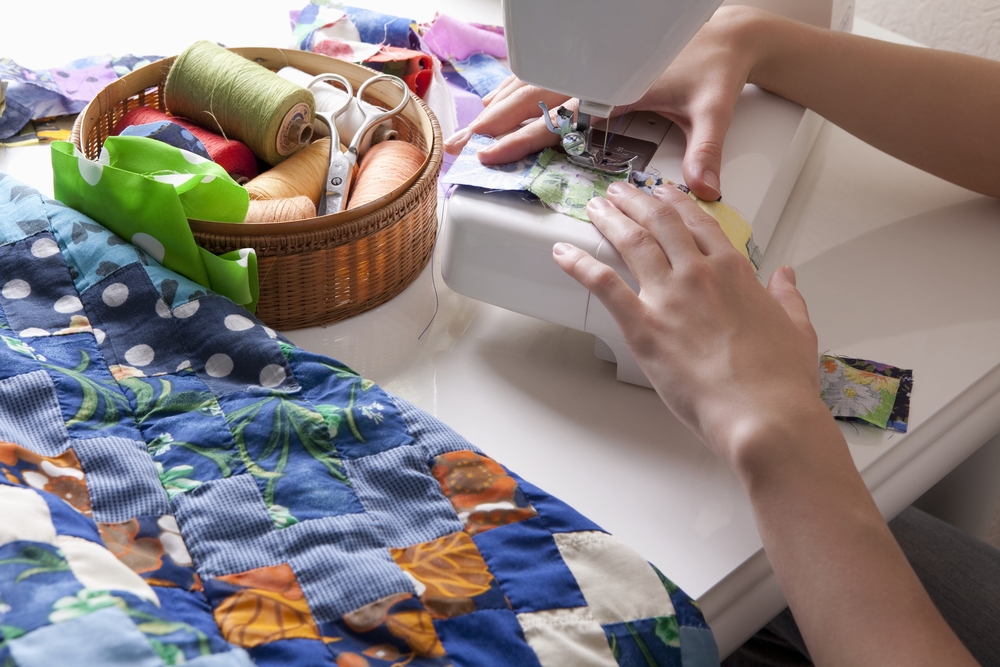Quilting is a hobby enjoyed by lots of creative people but it’s not for everyone. It is very time consuming and takes a lot of patience. Quilting on a sewing machine is a fun hobby that can be done quicker than quilting by hand. This can be done by using a regular sewing machine too.
If you know your way around a domestic sewing machine, quilting is not a difficult project to finish. Many quilters find the process to be very soothing, mindless, and relaxing. It is perfect for beginning to intermediate levels of sewing. We just released the Brother XM2701 review article, check it out here.
Start By Setting Up a Proper Workspace
To start, set up your sewing machine on a table that will give you plenty of space to work with the quilt. There should be extra space behind the sewing machine and on the side of the table you are working on.
Sewing quilts usually entail three different layers. To help keep your layers together, prep your layers by lining them up and pinning them down with curved safety pins. The pins should be about a hand’s width apart from each other. The pins do not have to be symmetrically lined up to each other, they can be staggered.
Use a Basting Spray Instead of Pins
You may also use a basting spray. If using the basting spray, be sure that is specifically for sewing so that it does not produce gumming on your needles. Basting is so much faster than pinning. It may leave a sticky residue so be careful around the edges and protect the surface you are working on.
Lay out your “quilt sandwich.” The quilt sandwich is simply the three layers you are working with. Place down the backing fabric with the print side down, then lay the batting on top, and then the top piece with the print side up.
The backing fabric and the batting laters should be one to two inches larger than the top layer since there will be some movement of those layers as you are stitching. The top layer of the classic quilt is the fabric made by sewing smaller block pieces of fabric together.
The Most Difficult Part…
You will begin by sewing from the middle of the quilt and working your way out. Note that sewing down the middle first is the most difficult part since it is when you will have the most fabric going through the machine. For this project, we will simply follow the classic quilt look by following the ditches on the quilt top pattern.
Start sewing a series of quilting channels the length of the quilt. It is easy working with a classic quilt top that consists of block patterns, since you can sew straight along the lines by following the ditch. The ditch is the seam lines between the smaller block pieces of fabric sewn together.
How to Stuff & Fluff
To “stuff & fluff,” start at the top of the quilt, back stitch, and sew about three to four inches down. Upon stopping, pull the needle down to anchor the fabric in place, and fluff up all the excess sitting on your lap and around the machine.
Lifting it up will ensure that the weight of the fabric is not fabric being pulled. Stuff the excess fabric on the left side through the hole (called the throat) of the machine, and smooth out the channel of fabric in front of you to continue.
Continue stitching, holding the fabric firm but loose enough to ensure an even pull for the excess fabric all around. For every few inches, repeat the “stuff and fluff” process. Remember to keep the weight of the fabric loose, but straight enough to keep your lines even.
Handling the Excess Fabric is Important
Pull up excess fabric anytime you feel the weight dragging. Do not forget to pull the needle down to anchor the fabric down every time you stop to adjust the quilt. Backstitch upon reaching the end.
From the middle of the quilt, sew channels in the same way working your way down the right side first. Then, flip it over to continue working down the left side. You may choose to sew evenly spaced channels throughout your quilt, or you can simply follow the seam ditches between each block.
Remember that the more you do it, the better you get at it! Many quilters love the notion that there is no need to be overly picky about the quilt making process.
This makes quilting the perfect undertaking for new and seasoned sewers to take on. With the basics in mind, quilting should be an easy going and enjoyable process!

